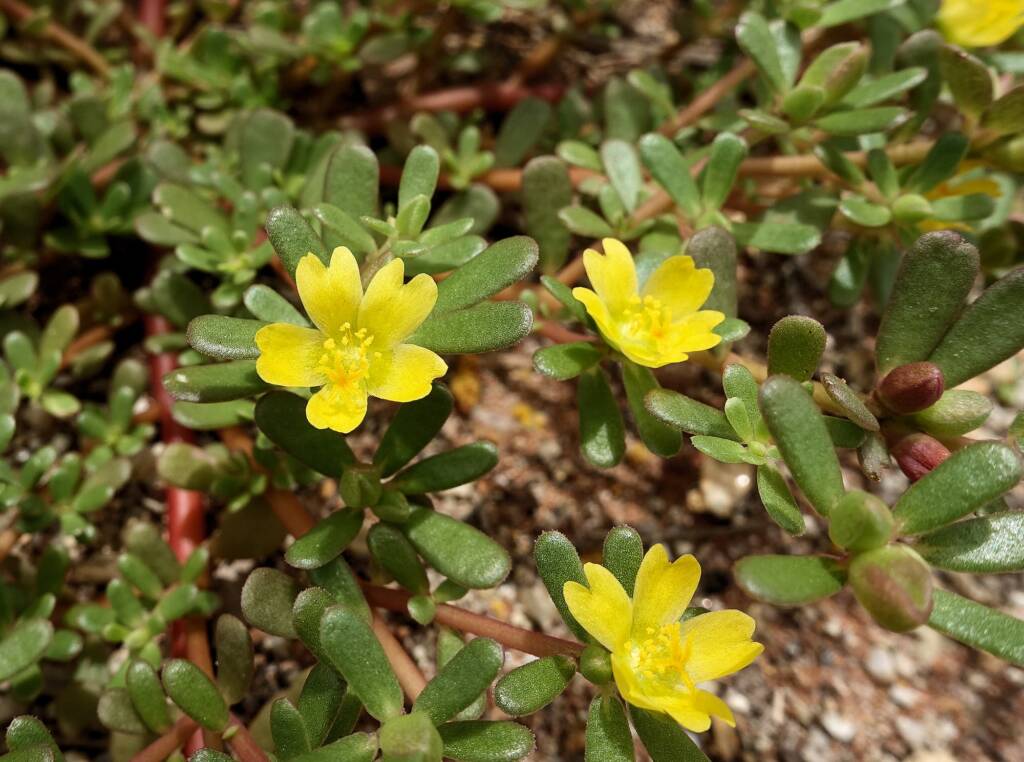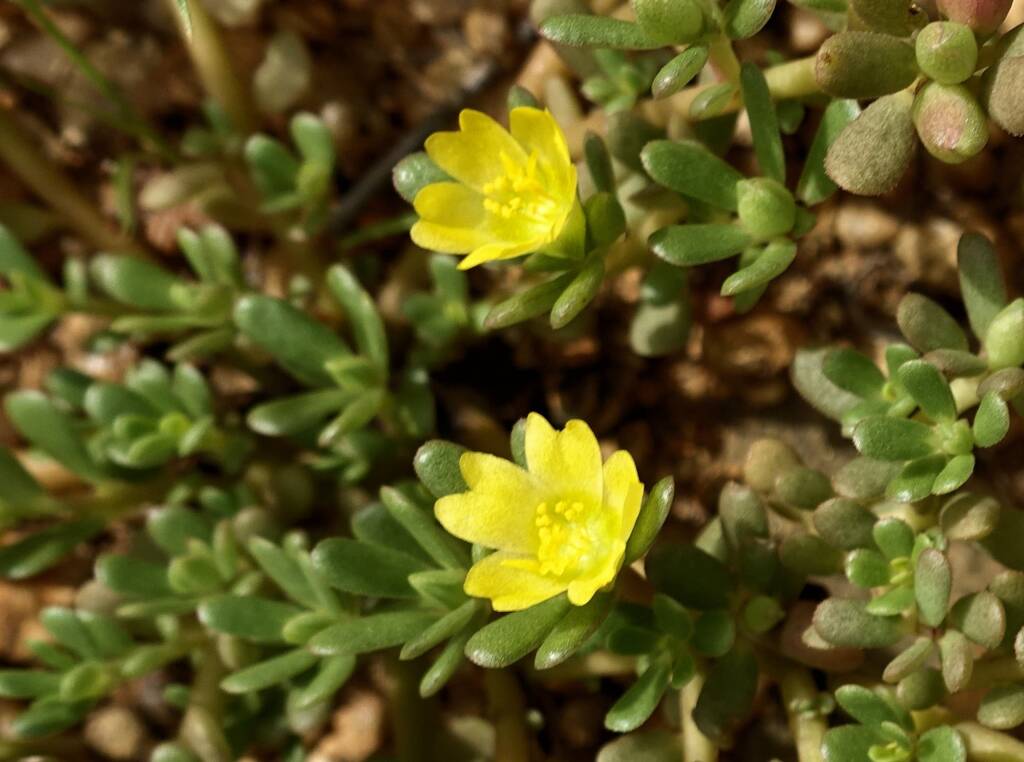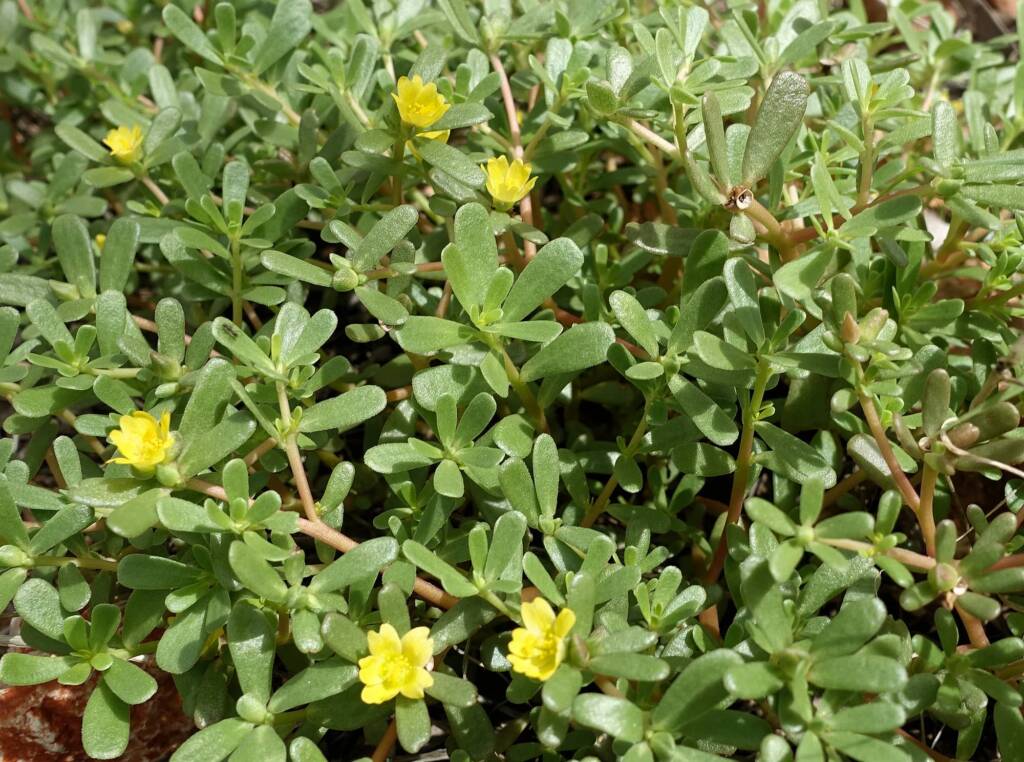PortulacaPortulaca intraterranea
Commonly known as Buttercup Pigweed, or Buttercup Pigface, Portulaca intraterranea is a small succulent that is very similar to Portulaca oleracea.
The leaves spiral along the stems, nearly opposite each other, and are about 0.5-2.5 cm long, 4-10 mm wide. The leaves are flat, hairless, and with blunt or sometimes notched tips. The flowers are yellow, with 5 notched petals, singularly or up to cluster of 4 at the bases of the leaves.







Common name
Buttercup Pigweed, Buttercup Pigface, Large Pigweed.

A prostrate, sprawling succulent herb, it is both an annual or sometimes a perennial forb that is native to arid desert regions of Central Australia.
This large pigweed has thick taproot that is eaten and tastes like potato.
| WARNING Extreme care must be taken when identifying edible food plants and those used in bush medicine. Some bush foods are only edible at different stages of the plant cycle, or when treated appropriately. Bush medicine should only be used under the guidance of a qualified physician. Information here is only provided for research. You should always seek experts in the field to confirm the identification of the plant and whether they are edible or appropriate. |

- Scientific classification
- Kingdom: Plantae
- Phylum: Tracheophyta
- Suibphylum: Angiospermae
- Class: Magnoliopsida
- Order: Caryophyllales
- Family: Portulacaceae
- Genus: Portulaca
- Species: Portulaca intraterranea
Footnote & References
- Portulaca intraterranea, iNaturalistAU, https://inaturalist.ala.org.au/taxa/1261552-Portulaca-intraterranea
- Portulaca intraterranea – A “Desert Gem”, by Blogger Grey Gum, 1 February 2013, http://australianportulaca.blogspot.com/2013/02/portulaca-intraterranea-desert-gem.html
PortulacaPortulaca intraterranea
FloraFlora in Australia Flora Index Acacia Anigozanthos (Kangaroo Paws) Annual Yellowtop Apium prostratum subsp. prostratum var filiforme Apple Bush (Pterocaulon sphacelatum) Australian Bluebell Australian Gossypium Banksia Batswing Coral Tree Billy Buttons Birdsville Indigo Blue Pincushion Bush Banana Callistemon Callitris drummondii (Drummond’s Cypress Pine) Calothamnus quadrifidus Cape Honeysuckle Cassia fistula (Golden Shower) Cattle Bush Common Heath Crotalaria Darwinia wittwerorum (Wittwer’s Mountain Bell) Daviesia oppositifolia (Rattle-pea) Desert Oaks Drumsticks Eremophila Eucalyptus Ficus Flannel Cudweed (Actinobole uliginosum) Georges Indigo Goatshead Burr (Sclerolaena bicornis) Golden Everlasting Goodenia Gossypium Grass and Grasses Grass Trees Grevillea Grey Germander Hakea Kapok Bush (Aerva javanica) Lambertia sp Leptospermum MacDonnell Ranges Cycad Maireana scleroptera Mexican Poppy Minnie Daisy Mistletoe Family Nardoo Native Apricot Nicotiana megalosiphon subspecies sessilifolia Nuytsia floribunda Orange Spade Flower Orchidaceae Parakeelyas (Calandrinia) Pebble Bush (Stylobasium spathulatum) Perennial Yellow Top Pink Everlasting Pink Rock Wort Poached Egg Daisy Portulaca Proteaceae Ptilotus Quandong Resurrection Fern Rosy Dock Ruby Saltbush Santalum Solanum Spike Centaury Spinifex Storkbill (Erodum cygnorum) Striped Mint Bush Sturt’s Desert Pea Sturt’s Desert Rose Tall Saltbush Tangled Leschenaultia Tar Vine Tribulus eichlerianus Upside-down Plant Urodon dasyphylla Variable Daisy Waratah (Telopea) Wertabona Daisy White Cedar (Melia azedarach) White Indigo White Paper Daisy Wild Passionfruit Wild Stock Woolly-Headed Burr Daisy Woolly Bush Yellow-keeled Swainsona
Flora & FaunaFauna Flora Fauna Flora Funga Glossary Funga Related Topics Scientific Classification Backyard Wildlife Floral Emblems of Australia Wildflowers
